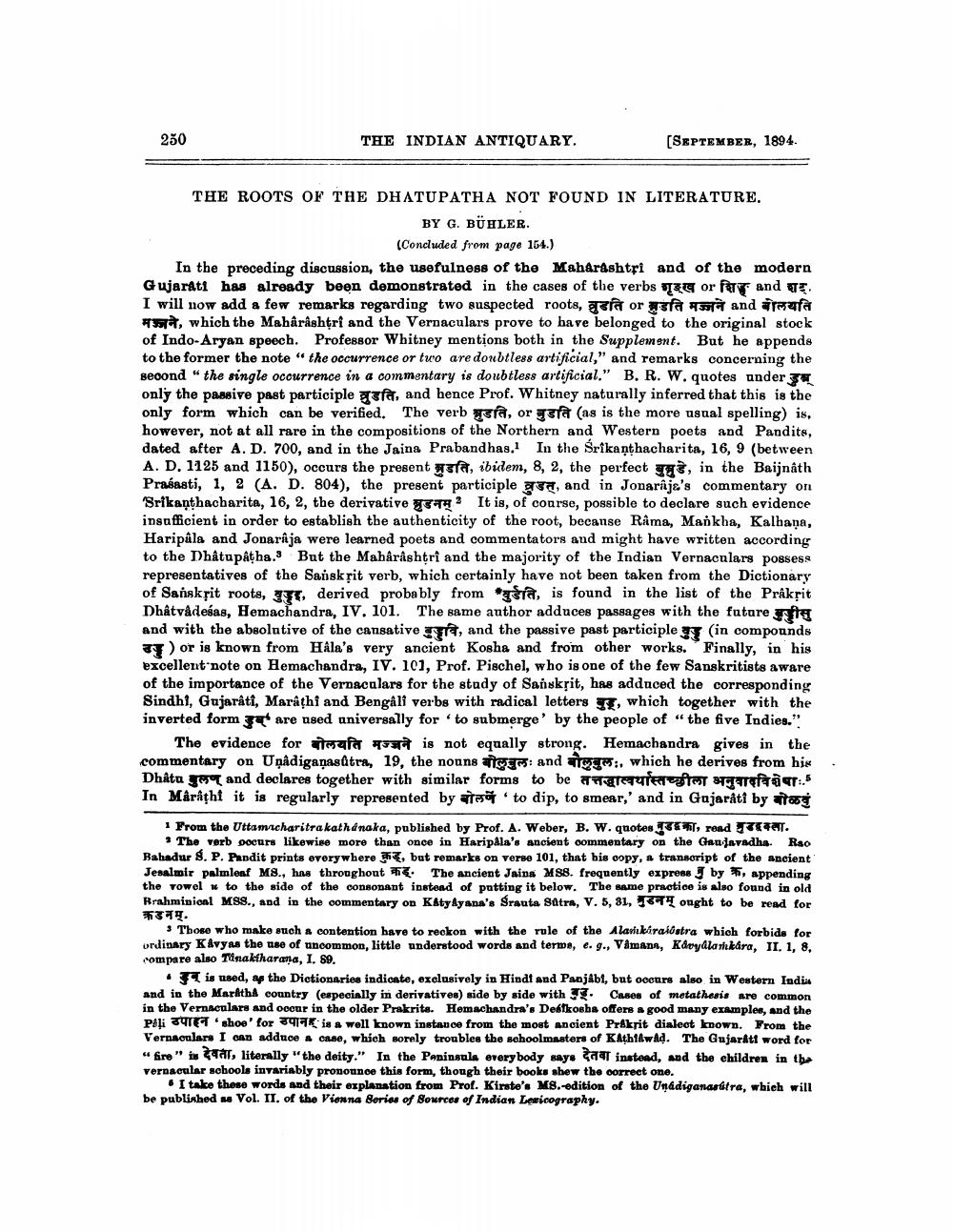________________
250
THE INDIAN ANTIQUARY.
[SEPTEMBER, 1894.
THE ROOTS OF THE DHATUPATHA NOT FOUND IN LITERATURE. BY G. BÜHLER.
(Concluded from page 154.)
In the preceding discussion, the usefulness of the Maharashtri and Gujarati has already been demonstrated in the cases of the verbs I will now add a few remarks regarding two suspected roots, वुडति or बुडति मज्जने and बोलयति
of the modern or fay and
2
, which the Mahârâshtri and the Vernaculars prove to have belonged to the original stock of Indo-Aryan speech. Professor Whitney mentions both in the Supplement. But he appends to the former the note "the occurrence or two are doubtless artificial," and remarks concerning the second "the single occurrence in a commentary is doubtless artificial." B. R. W. quotes under only the passive past participle fa, and hence Prof. Whitney naturally inferred that this is the only form which can be verified. The verb fa, or gefa (as is the more usual spelling) is, however, not at all rare in the compositions of the Northern and Western poets and Pandits, dated after A. D. 700, and in the Jaina Prabandhas. In the Srikanthacharita, 16, 9 (between A. D. 1125 and 1150), occurs the present fa, ibidem, 8, 2, the perfect, in the Baijnath Prasasti, 1, 2 (A. D. 804), the present participle 3, and in Jonaraja's commentary on Srikanthacharita, 16, 2, the derivative 3 It is, of course, possible to declare such evidence insufficient in order to establish the authenticity of the root, because Râma, Maňkha, Kalhana, Haripala and Jonarâja were learned poets and commentators and might have written according to the Dhâtupâtha. But the Mahârâshtrî and the majority of the Indian Vernaculars possess representatives of the Sanskrit verb, which certainly have not been taken from the Dictionary of Sanskrit roots,, derived probably from sa, is found in the list of the Prakrit Dhâtvadesas, Hemachandra, IV. 101. The same author adduces passages with the future and with the absolutive of the cansative, and the passive past participle (in compounds a) or is known from Hâla's very ancient Kosha and from other works. Finally, in his excellent note on Hemachandra, IV. 101, Prof. Pischel, who is one of the few Sanskritists aware of the importance of the Vernaculars for the study of Sanskrit, has adduced the corresponding Sindhi, Gujarati, Marathi and Bengali verbs with radical letters, which together with the inverted form are used universally for 'to submerge' by the people of "the five Indies."
The evidence for af is not equally strong. Hemachandra gives in the commentary on Unâdiganasútra, 19, the nouns : and :, which he derives from his Dhatu बुलण् and declares together with similar forms to be तत्तद्धात्वर्थास्तच्छीला अनुवादविशेषाः 5 In Mârâţht it is regularly represented by to dip, to smear,' and in Gujarati by
6
1 From the Uttamacharitrakathanaka, published by Prof. A. Weber, B. W. quotes, read
T.
The verb occurs likewise more than once in Haripâla's ancient commentary on the Gaujavadha. Rao Bahadur S. P. Pandit prints everywhere, but remarks on verse 101, that his copy, a transcript of the ancient Jesalmir palmleaf MS., has throughout. The ancient Jains MSS. frequently express J by, appending the vowel u to the side of the consonant instead of putting it below. The same practice is also found in old Brahminical MSS., and in the commentary on Katyayana's Srauta Sûtra, V. 5, 31, ought to be read for क्रडनम्.
3 Those who make such a contention have to reckon with the rule of the Alankaraiostra which forbids for ordinary Kavyas the use of uncommon, little understood words and terms, e. g., Vimana, Kavyalamkára, II. 1, 8, compare also Tinakiharana, I. 89.
⚫ is used, as the Dictionaries indicate, exclusively in Hindi and Panjabi, but occurs also in Western India and in the Maratha country (especially in derivatives) side by side with Cases of metathesis are common in the Vernaculars and occur in the older Prakrits. Hemachandra's Desfkosha offers a good many examples, and the Pili shoe' for 3 is a well known instance from the most ancient Prakrit dialect known. From the Vernaculars I can adduce a case, which sorely troubles the schoolmasters of Kathiawaḍ. The Gujarati word for "fire" is, literally "the deity." In the Peninsula everybody says instead, and the children in the vernacular schools invariably pronounce this form, though their books shew the correct one.
I take these words and their explanation from Prof. Kirste's MS.-edition of the Unådiganasútra, which will be published as Vol. II. of the Vienna Series of Sources of Indian Lexicography.




